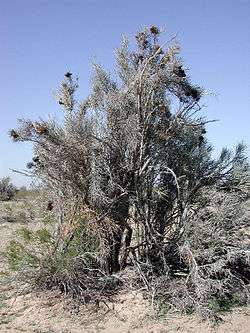Castela emoryi
Castela emoryi, with the common names crucifixion thorn and Emory's crucifixion-thorn, is a shrub species in the genus Castela of the order Sapindales.[1]
| Castela emoryi | |
|---|---|
 | |
| Castela emoryi | |
| Scientific classification | |
| Kingdom: | Plantae |
| Clade: | Tracheophytes |
| Clade: | Angiosperms |
| Clade: | Eudicots |
| Clade: | Rosids |
| Order: | Sapindales |
| Family: | Simaroubaceae |
| Genus: | Castela |
| Species: | C. emoryi |
| Binomial name | |
| Castela emoryi | |
| Synonyms | |
|
Holacantha emoryi A. Gray | |
Distribution
The plant is native to the Mojave Desert and Sonoran Deserts of North America.
It is found in southern California, Arizona, and Sonora state (México).[1]
Description
Castela emoryi is often less than 1 metre (3.3 ft), and occasionally to grows 4 metres (13 ft) or more.[2]
It is ranked on the California Native Plant Society Inventory of Rare and Endangered Plants, as an endangered species within California, and more common elsewhere.[3] It is threatened by solar energy development and military activities within its California range.[3]
Uses
The Yavapai people traditionally used this as a medicinal plant, making a dermatological aid from its bud's sap.[4]
Insecticide and fungicide
Castela emoryi is a plant toxin insecticide. It contains quassinoids such as glaucarubolone glucoside which has antifeedant properties against termites such as Reticulitermes flavipes,[5] or potential fungicidal activity for the control of grape downy mildew.[6]
It also contains glaucarubol, a compound characteristic of the family, ellagic acid, betulin and (—)-syringaresinol.[7]
References
- Jepson: Castela emoryi
- CalFlora: Castela emoryi
- California Native Plant Society−CNPS, Inventory of Rare and Endangered Plants: Castela emoryi . accessed 9.9.2015.
- University of Michigan at Dearborn: Native American Ethnobotany for Castela emoryi
- Antifeedant properties of natural products from Parthenium argentatum, Parthenium argentatum, ×Parthenium tomentosum (Asteraceae) and Castela emoryi (Simaroubeaceae) against Reticulitermes flavipes. Carmen Gutiérrez, Azucena Gonzalez-Coloma and Joseph J. Hoffmann, Industrial Crops and Products, Volume 10, Issue 1, June 1999, Pages 35–40, doi:10.1016/S0926-6690(99)00003-5
- Glaucarubolone glucoside, a potential fungicidal agent for the control of grape downy mildew. Joseph J. Hoffmann, Shivanand D. Jolad, Louis K. Hutter, Steven P. McLaughlin, Steven D. Savage, Scott D. Cunningham, Jean Luc. Genet and George R. Ramsey, J. Agric. Food Chem., 1992, 40 (6), pages 1056–1057, doi:10.1021/jf00018a029
- Constituents of holacantha emoryi. W. Stöcklin, L.B. De Silva and T.A. Geissman, Phytochemistry, Volume 8, Issue 8, August 1969, Pages 1565–1569, doi:10.1016/S0031-9422(00)85931-2
External links


- CalFlora Database: Castela emoryi (Cricifixion Thorn)
- Jepson Manual eFlora (TJM2) treatment of Castela emoryi
- UC Photos gallery — Castela emoryi